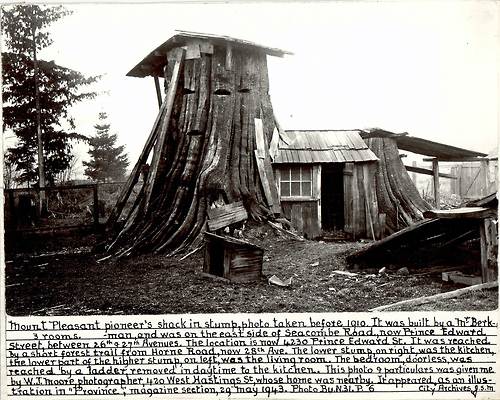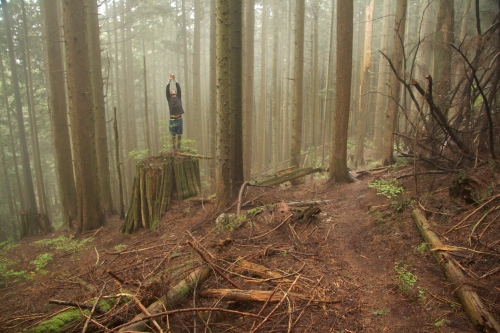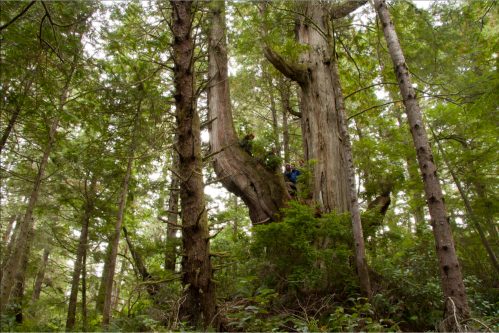Contents of this guide:
-
Introduction to super stumps.
-
A stump hunter’s guide for Vancouver and area

Visit immense stumps to uncover an impressive legacy of our former forests.
1) Introduction to super stumps
It’s easy to sense the allure and mystery of large and old trees when walking into an old-growth forest. But forests with such large trees have been logged out over the past century and are now rare. Only their great stumps remain. Young recovering forests found all around Vancouver still bear the rooted remains of their former giants. Within these young forest find colossal ancient ‘super stumps’ —structures of wood several meters high and wide twisted together by once living grain. Super stumps are an illustrative piece of the great former forest of our region. My aim here is to investigate these stumps and share their story, which tells of our city’s recent pioneer past: In only 150 years, Vancouver’s growth has supplanted a verdant coastal rainforest, home to coastal First Nations and some of the tallest trees on earth.

Imaginative rendition of historic forests near New Westminister, BC
Historically, the region in south west BC was sometimes known as the ‘Great Vancouver Forest,’ a term used to describe the towering green canopy covering the region. Home to the Coast Salish First Nations, these forests were truly ‘ancient,’ containing trees twice the age of Machu Pichu and taller than those anywhere else on Earth.

But then in 1885, the Canadian Pacific Railway arrived across the country stimulating rapid growth that, within a few years, turned the 400 person settlement of Granville (at present day downtown) into a lumber-hungry town of 10,000. Lumbering fueled growth of the economy. As the population grew, tree falling propagated outwards from the town center along the shore, up mountain valleys, and deep into the wilderness.

Giant stumps at false Creek in 1890 —a time of explosive transformation: forest clearing and city growth
After harvesting a patch of forest, immense stumps, snags and downed wood smothered the land. To make way for agricultural and urban settlement, the stump-filled forest floor had to be dug up, split, sawn, and dynamited, and burned to mineral soil.

A hollow stump on the Vancouver exhibition grounds 1913
However, in a few places on the outskirts of development, stumps remained in place as large and intact legacy ecosystem components. The great wooden structures returned to life, but this time providing habitat for plants and animals and energy for colonizing fungi and bacteria. Sometimes humans even found habitat in the stumps. They used the red-cedar stumps for shelter: pioneers built roofs over their hollow centers and used them as barns for livestock or houses to live in. Historic images illuminate the fact that the lifestyle and housing conditions within Vancouverite have greatly changed in only 100 years (and likely will continue to do so).

This incredible stump house was near the present location of Vancouver’s Queen Elizabeth park
Great stumps lay all around us, often not far from where we live and play. In many places where the old-growth was cut, the land re-vegetated and young trees have grown up forming a mature forest that partially conceals the great stumps. Yet in these forests, found all around Vancouver, there are super stumps to discover. Giant stumps are prominent in Pacific Spirit Park, Stanley Park, Capilano Canyon, Lynn Valley and other places. In fact, nearly all forests around Vancouver bear the conspicuous mark of wide stumps where the ancient trees once grew.

Sometimes they attract tourists, journalists, or curious kids, but most often, these ubiquitous large stumps are simply forgotten. Below I’ve outlined remarkable super stumps for you to visit.

Big stumps within a recovering forest in West Vancouver.
2) A stump hunter’s guide for Vancouver and area
If your interested to see large and impressive stumps remaining, focus on those of western red-cedar (Thuja plicata) trees. No other native species has a trunk with similar gigantic width and buttressing. In fact, red-cedar are the largest diameter tree species in Canada, sometimes exceeding 5m in diameter —longer than a pick-up. Red-cedar trunks have wide spreading root structures that buttress them against wind and give them an impressive girth at ground level. Red-cedar wood is resistant to decay, such that even in the wet coastal temperate forest some stumps remain hard, usable and valuable lumber for >100 years after its death. Loggers sometimes referred to as ‘Cedar rats,’ especially when living on hard times, salvage remaining cedar scraps by bucking off large chunks by saw then splitting them with a froe (or by machine) into merchantable strips called cedar shakes (meet one here: video).

The hollow stump at Stanley Park (above) is by far the most famous red-cedar stump. It was already dead and burned out when the first immigrating settlers arrived to the region in the 1850’s. Many portraits of early settlers feature the stump. Due to the stumps high cultural heritage values the hollow stump was refurbished in 2012 following heated debates between a coalition of supporters and Park Board staff who failed to understand the importance of the tree and promoted its destruction (see this must watch film on The Hollow Stump). It’s now solidly supported with steel poles so that it will likely last another hundred years or more.
Pacific Spirit Park has impressive stumps of cedar and Douglas-fir (guide). Unbeknownst to most of the most UBC staff, students and faculty, large cedar stumps even litter the urban forests found directly on UBC campus, such as those outside the Nitobe Memorial Gardens.
Lynn Valley, rumoured to have once been home to the largest trees in world, has massive stumps to discover. One can be seen about 2/3rd of the way to the famous giant 4m wide cedar on the west side of Lynn Creek. Huge cedar stumps are every where in Lynn Valley entrenching a picture of what the immense historical forest was once like. Lynn Valley, especially on a misty day, tends to pull your imagination back into time; a hike through the valley is one of the easiest and best escapes from the city. Today, it’s mostly dense second-growth hemlock with relatively low predominance of cedar. One actual tract of old-growth cedar does remain beyond Kennedy Creek (here), but this is only accessible for the intrepid and experienced hiker to discover. Capilano Valley reportedly held a stump more than 6m in diameter. Look in any forest near your home and you will likely find a stump with a story.
Seymour Valley Super stumps
There is no question, however, that Seymour Valley is home to the most impressive local stumps. Discovered by big tree researcher Ralf Kelman and mapped by the Western Canada Wilderness Committee, the “super stumps,” as they were coined in a highly coveted big tree map produced by the Wilderness Committee, can be easily accessed 5km’s up valley. To get there you must ride a bike (recommended), walk, or run up the Seymour Valley Parkway ~5km and shortly BEFORE you arrive at McKenzie Creek (signed, and with a bridge, located about here) take a right off the parkway onto a gravel road that traverses downhill to the east. If you arrive to the bridge crossing McKenzie creek GO BACK. Head downhill along the gravel road, skirt around the fence gate by following the left side, and now walk along the gravel road with your eyes open for large stumps off into the forest on both sides. Try to find the first, below (to the north of this road), which I’m calling the ‘Westworld stump’ because my photo of it was featured in WestWorld magazine in 2011. The accompanying article hints at extraordinary big trees nearby, which almost became stumps as well…. I leave some of the discovery for you.

The second is so large that it can still be seen with a group of 30 people in front of it.

The author Ira Sutherland and the Ancient Forest Alliance giving a tour of the Seymour Valley super stumps in 2011.
Depending on which one you’ve found first you should be in clear view of the next photogenic monstrosity. Once you have explored that area head back onto the Seymour Valley Park Way and continue north. A little ways past the 6km marker on the left is the sign-posted ‘See-more stump trail’. Walk one minute up the trail to find a remarkable nearly lost monument to the old-growth forest. Coined the See-more stump, this is the ultimate Vancouver super stump. It bears several layers of springboard notches, which the loggers used to insert planks that then stood on so that they could saw above the trees wide swollen base. Nearly all cedar stumps logged historically bear these notches.

Just another red-cedar stump on the Seymour Valley Parkway. Hardly any larger than the average you’ll see…
By my estimation, this grove of cedar was once a magnificent grove on par with just about any other cedar grove in the province. Today, there is no record of it aside from the stumps left rooted to the soil. Regrettably, few groves of exceptionally large red-cedars were retained in the Vancouver area —most were logged out. Stanley Park has some remnant giants. Lynn Valley has one well known one as well as lots more impressive cedars at much higher elevation. The lesser known Brother’s Creek area has an incredible grove mixed with red and yellow cedar, with trees over 1200 years old.

The ‘See-More’ super stump. The most impressive discovered yet
Where Can I find the Biggest red-cedar in BC?
Fortunately, outside Vancouver you may still travel to find magical groves of large cedar. A popular spot is the Avatar Grove on Vancouver Island as well as the ancient cedar grove near Whistler; the most impressive and rewarding in my opinion is the Big Tree Trail on Meares Island, near Tofino, where the humid canopy environment supports wide hanging gardens of plants and moss seen high up in the cedar crowns. The largest western red-cedar in BC is the Cheewaht Lake Giant (must see video), which is 55.5m tall and 5.84 m in diameter (according to the BC Big Tree Registry).
It is important to recognize that many ancient cedars are continually logged off today, such as those in the Walbran Valley. The logging of these trees and rapid liquidation of BC’s ancient forests in only 150 years since settlement is unsustainable in the true definitive sense of the word unsustainable. This is clearly seen by visiting stumps of great trees, which allows us to imagine for ourselves how it long it takes the trees to once again obtain such size.

One of many giant red-cedars on the Meares Island big tree trail, Tofino, BC.
The Ancient Forest Alliance, a local environmental organization, maintains an illuminating and award winning stump gallery, which shows the type of trees being cut still in logging today. Photographer and forest guide TJ Watt can potentially arrange Vancouver Island stump and big tree tours.
Super stumps resurrect our awareness
Nearly everywhere you go around Vancouver, you can focus in on these immense stumps. The stumps provide a point for reflection to appreciate our floristic and cultural history. Few places on Earth ever once contained trees so large. The intactness of many stumps is testament to not only the durability of west coast timber, but also the recent timeframe that dramatic changes swept through this land. The felling of our world renowned forests, home to many First Nations groups, happened recently and quickly, permanently altering the region’s identity and way of life. This process continues today in 2016 at a rate that is difficult to gauge as the provincial government continues to license and encourage the cutting of our great heritage groves without a solid knowledge or inventory of what is being lost.
Currently, giant stumps are gaining mainstream cultural recognition as Vancouverites wake up to the uniqueness of the forests around us and their link to our very own past. Several recent public art pieces in Vancouver are inspired by the remarkable aesthetic of old-growth stumps. A new work of public art by Douglas Coupland features the Stanley Park Hollow Stump replicated, in gold, at Marine and Cambie streets. I imagine Coupland made it gold to reflect the cultural, ecological, and economic (through tourism) value of this artifact. The TransAM Totem by Marcus Boycott, featuring a real and massive cedar stump stacked with 70’s Pontiac Trans Ams at 1273 Quebec Streets, provides opportunity to ponder our history and relationship with old-growth logging. The tranquility of our coastal forests, and the curiosity sparked by the image of remaining stumps is depicted beautifully by the work of Marina Roy at her display Your Kingdom to Command at West Georgia and Thurlow.

Public art: The Golden Tree by Douglas Coupland replicates the Stanley park Hollow Stump (Photo from CBC)
These art are surfacing in Vancouver in parallel with a rising global appreciation that our culture and society are intrinsically tied to the ecosystems around us and how we have shaped them through time. The move toward recreating in nature and especially getting kids outside, is shifting the planning of playgrounds to embrace the aesthetics of nature and forests. For the first time in a century, stump house are being constructed. For example, one is being built for children to play in at the UBC Research Forest in Maple Ridge, BC (seen below). Visiting stumps can be fun for the whole family.

Recreating a historic stump house in the UBC Research Forest, Maple Ridge, BC. Work by Tom Bissky.
An intertwined story of nature and human culture, greed, and inspiration is told through the legacy stumps found across our region. Some of the trees were more than 1000 years old when cut 150 years ago. They may remain intact for a hundred years more. The super stumps around us tell a unique intergenerational, cross-millennial story of who we are and where we have come from. Take a trip and go find the stories of the stumps, marked by time, axe, and sometimes rusting artifacts; there for you to discover.
Acknowledgements
This post is dedicated to Ralf Kelman, one of the most passionate and successful stump hunters around, and the Western Canada Wilderness Committee. Ralf more than anyone knows that the story of these stumps was one that had to be told. Without his and the Wilderness Committee’s awareness raising map of the Seymour Valley, I may have never stepped forward and began this journey into Vancouver’s arboreal past.
